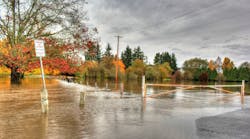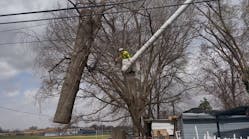When a wildfire ravages through a forest, what’s left behind is often referred to as burn scar. During heavy rains, liquids run off this water-repellent terrain like pavement, often causing flash flooding, debris flows, and mudslides. Because burn scar terrain fails to absorb rainfall as normal soil does, much less rainfall is required to produce a flash flood in these areas — especially in locations downhill and downstream from burned areas.
According to the National Weather Service, "If you can look uphill from where you are and see a burnt-out area, you are at risk.”
When water travels downward through burn scars, it will pick up ash, sand, silt, rocks, and burned vegetation (aka trees) along the way. This stream of debris can cause serious damage along the way.
When in doubt, the National Weather Service suggests following this general rule of thumb: Half an inch of rainfall in less than an hour is sufficient to cause flash flooding in a burn area, but this can differ depending on contributing factors.
Turn Around Don't Drown®
According to the Centers for Disease Control and Prevention, more than half of all flood-related drownings occur when vehicles are driven into hazardous flood water.
The takeaway? Turn Around Don't Drown®, as the National Weather Service likes to remind anyone who encounters a flooded roadway.
Be sure to always adhere to road closures and other cautionary signs. Flooded roads may have significant damage hidden by murky floodwaters. If your vehicle stalls, remove yourself from the vehicle immediately and seek higher ground. Water only 2 ft deep can cause most automobiles to float away.
For additional flooding and extreme weather safety tips, view ACRT’s “Dealing with Extreme Weather” infographic.
Know What to Expect
What does "storm watch" mean?
A storm watch means that severe weather hasn't occurred yet, but upcoming weather conditions are expected to produce potentially dangerous weather, such as heavy rain, hail, or strong gusts of wind. Because conditions can change quickly, the National Weather Service wants to give you as much time as possible to safeguard your personal property and take shelter.
What does "storm warning" mean?
A storm warning indicates that meteorologists have already observed severe conditions. If you hear that a storm warning has been issued, it means potentially dangerous weather is imminent in or near your location. Take appropriate action as quickly and safely as possible.
Types of Storm Watches and Warnings
While the primary focus of this article is on flooding, there are several other types of extreme weather and ways to alert the public of dangerous situations.
Flash Floods. A flash flood watch signals that even if there isn't any standing water in your immediate area, you should be ready for those conditions to change at any moment. Flash flood watches can turn to warnings quickly, as flooding of nearby bodies of water are imminent or already happening. In either case, move to higher ground as safely as possible, and stay out of the flood's path.
Severe Thunderstorms. A thunderstorm watch, which can be in effect for several hours, means weather conditions exist where severe thunderstorms can easily develop. A thunderstorm warning means current storm conditions can turn worse, including heavy rain and strong winds. Whether a watch or a warning, it's best to stay inside and away from windows.
Tornadoes. April, May, and June are the most active months of the year for tornadoes to occur. A tornado watch means severe weather, such as large hail or winds over 58 m.p.h., has the potential to turn into tornadic activity. A tornado warning indicates that either a strong weather rotation could produce a tornado at any moment or that a funnel cloud has already been spotted. In either situation, seek shelter immediately and pay attention to local news updates.
Tropical Storms. Tropical storm watches are issued as early as possible to allow enough time for emergency prep — including the possibility of evacuation. If you hear a warning, though, a tropical storm is expected within the next 36 hours, and you should take shelter immediately.
Hurricanes. Whether there is a tropical storm expected to strengthen into a hurricane, or one that's already formed, a watch means a hurricane has the potential to impact your area. You should gather emergency supplies and prepare to act quickly. Warnings are typically issued up to three days in advance.
Winter Storm. A winter storm watch is usually issued at least 24 hours in advance of the storm. It lets you know that while hazardous weather conditions are likely, the exact areas and timing may not be known yet. If a watch is upgraded to a winter storm warning, try to avoid traveling, as visibility and road conditions can become unsafe.
Be Prepared
The first step to becoming weather-ready is to know your risk and understand the types of hazardous weather that can affect where you live and work. Know your routes & destinations and adopt a habit of checking your local weather report throughout your day. Before encountering any severe weather conditions, it is vital to have a plan and be prepared as possible.


